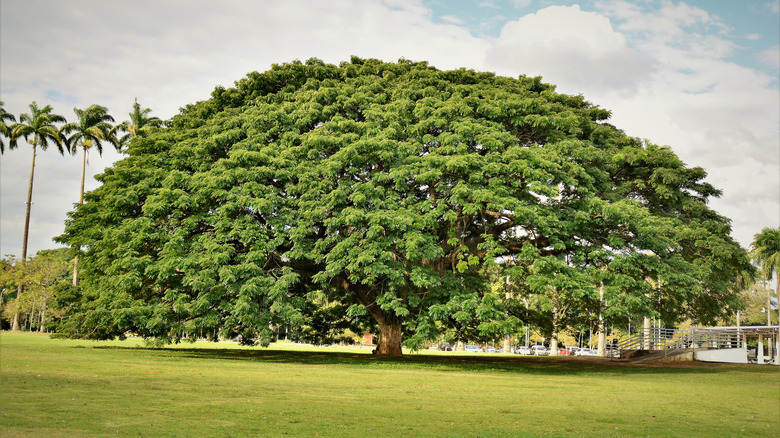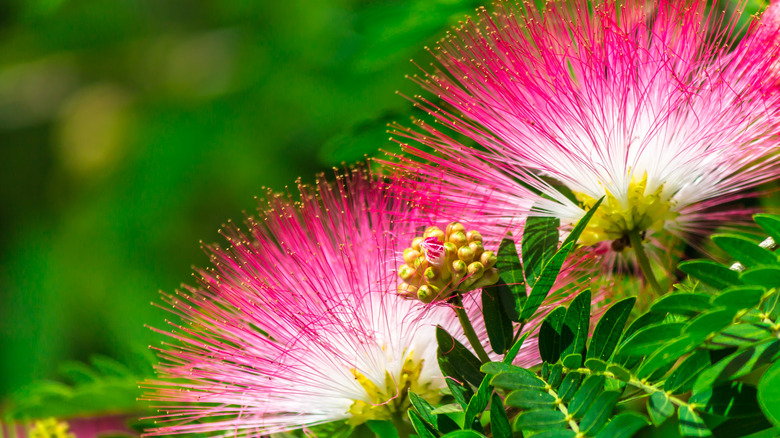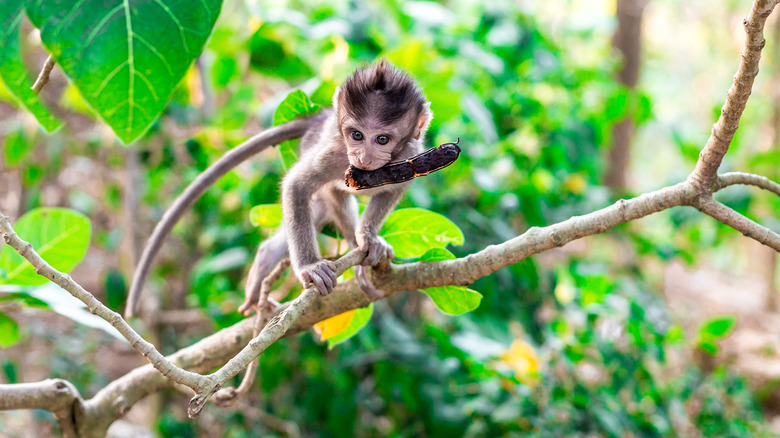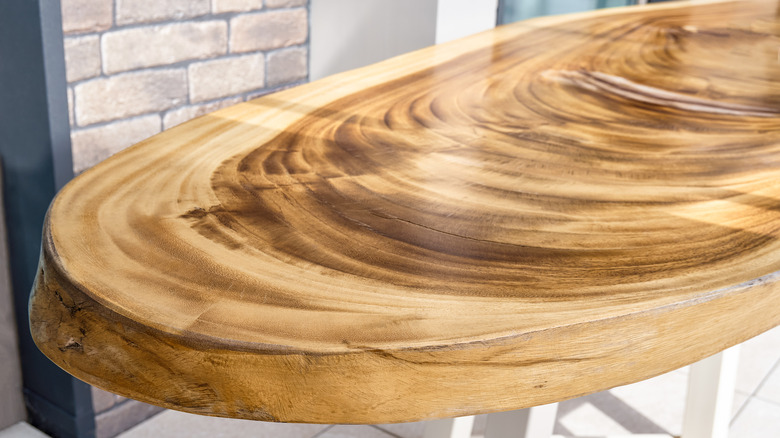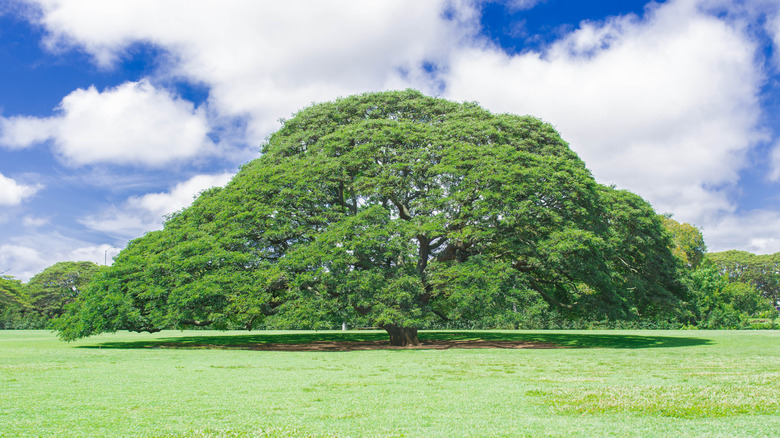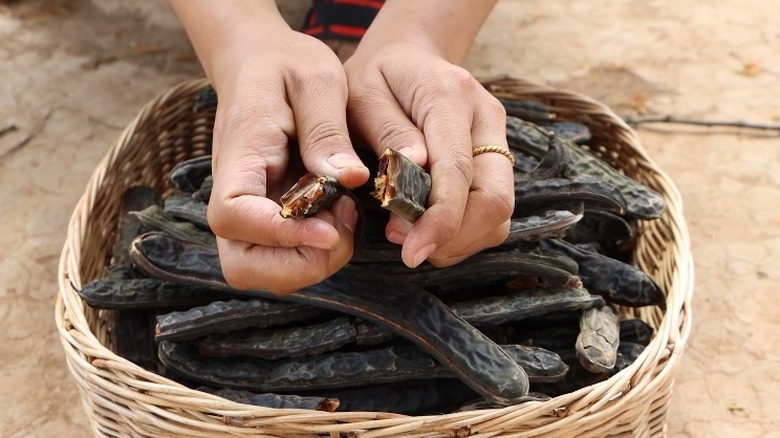What You Need To Know About The Monkey Pod Tree
The monkey pod tree (Albizia saman), named after its spiral-shaped fruit pods, is also commonly known as the rain tree due to the folding behavior of its leaves during rainfall or at night. With a lifespan of 80 to 100 years, the monkey pod grows up to five feet per year, and is considered semi-deciduous, which means that its leaves fall off temporarily during dry seasons. When the rainy season begins, the tree quickly regenerates new leaves and becomes lusher and fuller. In some climates, monkey pod trees regenerate so quickly that they appear to retain their leaves year-round. One of the distinctive features of monkey pod trees is their compound leaf structure, similar to that of a fern. These leaves fold up during the evening and on rainy days. During the summer months, these regal trees produce pom pom-like clusters of pink flowers.
The monkey pod tree's unique flowering schedule usually begins towards the end of the dry season, after it has shed its leaves and pods. Spring is typically the peak season for flowering, though it is not uncommon to find flowers on monkey pod trees during almost any month of the year. The timing varies depending on the region, with Central and South America experiencing the floral display between January and May, while April and May mark the prime months in Hawaii. In Thailand, these trees boast two distinct flowering seasons, spanning from February to May and from September to November.
It supports the environment
The monkey pod tree, also known as the rain tree, offers valuable environmental benefits through its unique characteristics. One of its remarkable contributions is nitrogen fixing, where certain plants have the ability to convert atmospheric nitrogen into usable forms for other living organisms. This natural fertilization process enriches the soil with nitrogen, promotes soil fertility, and supports the growth of neighboring plants. To accomplish nitrogen fixing, the rain tree forms a symbiotic relationship with a specialized bacterium called rhizobia, which can also be found in other woods like acacias, rosewoods, and koa. The bacteria live within nodules formed on the plant's roots, and produce an enzyme that converts nitrogen into ammonia. This ammonia is used by the host plant for growth and development.
The monkey pod tree has a robust root system that also helps protect against soil erosion. The tree safeguards the landscape by preventing erosion from water runoff and wind. Additionally, the tree's gigantic canopy acts like a giant shield that intercepts rainfall and reduces the impact of water droplets on the soil's surface. This effective interception greatly mitigates erosion, especially during intense periods of rainfall.
Lastly, it is important to note that all trees contribute to the conversion of carbon dioxide (CO2) into oxygen, which helps offset the impact of greenhouse gas production.
It provides homes for various species of creatures
The monkey pod tree serves as a vibrant hub of wildlife activity, offering homes to various species. Its captivating flowers attract nectivorous birds, butterflies, bees, and in certain regions of the world, squirrels. The monkey pod is known for playing host to an abundance of epiphytes and vines, and it's not uncommon for mature trees to often be engulfed by them. The wide-spreading canopy and dense foliage create shelter and nesting sites for a variety of bird species and provide protection from predators and extreme weather.
Monkey pod trees contribute to overall biodiversity by creating microhabitats within their branches, leaves, and bark. These microhabitats provide niches for a variety of creepy crawlies, including insects, spiders, and microorganisms like beneficial bacteria. In turn, these smaller creatures support the food chain and attract predators, fostering a diverse and balanced ecosystem. The tree's seed pods serve as a valuable and nutritional food source for birds and small mammals, and the flowers and nectar attract different types of insects.
Sustainably harvesting the wood benefits the local economy
Throughout history, the monkey pod tree has been cherished for its use in woodworking. It's a lightweight wood that's highly resistant to decay and termites, which makes it perfect for long-lasting projects. While it can be a bit challenging to work with, monkey pod wood became particularly renowned for the bowl trade in Hawaii, which took off in the 1940s (via Common Forest Trees of Hawaii).
When it comes to timber, the monkey pod tree is a dream for woodcarving enthusiasts. The grain varies from straight to interlocked or wavy, while its texture is medium to coarse. This hardwood is highly durable, displaying resistance to decay and most insect attacks. Working with monkey pod wood is generally easy, although interlocked grain may result in fuzzy or torn grain during planing. It showcases a range of colors, from golden to dark brown, and often has streaks of darker tones. Monkey pod wood is less prone to drying out and cracking. Because these are fast-growing trees, using their wood is an eco-friendly and sustainable option for artisans.
All parts of the tree are usable
The monkey pod tree isn't just beautiful; it's also functional and offers various benefits and uses. Its pulpy pods yield a flavorful fruit, which has earned it the title of "licorice tree" in certain regions of the Caribbean. In other cultures, the pulp is used to create a drink that tastes like a blending of tamarind and lemonade. Animals also eat the pods for their nutritional value. Different parts of the tree have been used in folk remedies around the world. In the Philippines, the inner bark and leaves are thought to help with digestion issues, while in Venezuela, the roots are steamed for therapeutic hot baths to manage stomach cancer symptoms. Locals in the West Indies chew on the seeds, which are believed to help alleviate sore throats. In certain regions, honey is harvested from the flowers, though it's not sold commercially.
Of course, the monkey pod tree is an excellent source of shade. These majestic trees have a wide-canopied structure with a large symmetrical umbrella-shaped crown, which makes it ideal for creating a cool and comfortable space with ample shade. Due to their fast growth rate, monkey pod trees quickly establish a dense and extensive canopy that effectively blocks sunlight and reduces the intensity of heat below. Their broad leaves and abundant foliage offer ample protection from the scorching rays of the sun, making them a popular choice for shade trees in various landscapes, parks, and recreational areas.
There are a few downsides
Unfortunately, monkey pod trees still have a few major downsides. In certain areas of the world, like Hawaii, this behemoth is categorized as an invasive species. It grows an average of five feet per year, according to Garden Guides, and its adaptability enables it to outcompete native vegetation, which causes serious disruptions to local flora and fauna. The monkey pod tree's substantial size can pose challenges in urban areas or confined spaces because its expansive canopy and sizable trunk require ample space to accommodate its growth. Like many trees, the monkey pod tree sheds leaves, flowers, and also messy sticky seed pods onto cars and unsuspecting passersby. Despite its majestic appearance, the monkey pod's branches can be vulnerable to breakage, particularly during storms or strong winds, which poses a safety risk. This means it requires frequent monitoring and pruning to keep it under control.
The monkey pod tree's root system can pose challenges for building projects and also for existing structures and can cause foundational cracking, sidewalk cracking, and uplifting, and also poses risks to underground piping and infrastructure.
